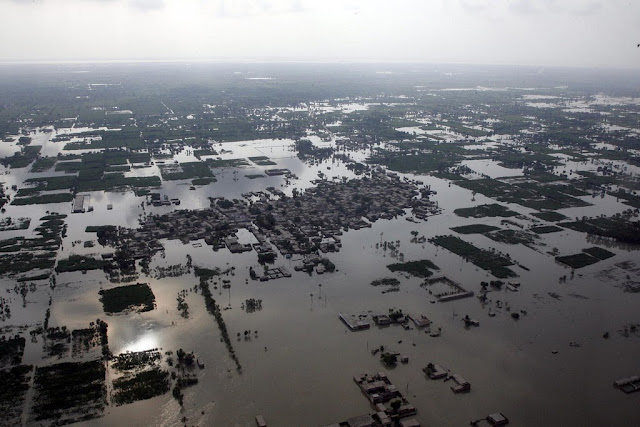-
Historic Floods Plague Pakistan
August 19, 2010 By Shawna Cuan“Staggered by the scale of destruction from this summer’s catastrophic floods, Pakistani officials have begun to acknowledge that the country’s security could be gravely affected,” reports the Washington Post. The Pakistani government – already cash-strapped between fighting “the war on terror” and trying to prevent an economic collapse – now faces recovering from the worst flooding in over 80 years.
Security Implications of Slow International Relief Efforts
Aid and relief have been scarce. According to the United Nations, not even a third of the estimated $459 million needed has been met. So far, the United States ranks as the largest contributor, at $71 million. Individual donors, Islamic charities, the Pakistani military, and the United States have been the most prominent actors in relief efforts so far.
The lack of international aid has become a major concern. As Ahmed Rashid wrote recently in The New York Review of Books, aid is needed immediately, for rebuilding bridges, restoring power, and reopening roads, particularly in the Khyber Pakhtoonkhwa province – a haven for Pakistani and Afghan insurgents.
Islamic charities have partially filled the void, providing substantial aid in some of the worst affected regions. “The patchy government response has given room for Islamist groups, some allegedly linked to militant outfits, to step in and offer their own aid to displaced and hungry flood victims,” reports the Associated Press.
Varied Government Responses
The Pakistani military has been just about the only competent component of state-run relief efforts. Tens of thousands of soldiers have been dispatched to assist in rescue operations. Already, 75,000 stranded people have been rescued, although rescue attempts have been heavily restricted due to challenging terrain.
The relatively weak government response – notably a lack of presence from the civilian side – has only further undermined its legitimacy in the eyes of ordinary Pakistanis, who have faced government incompetence before. “There is no silver lining, just misery for many,” concludes Bruce Riedel, a counterterrorism expert and senior fellow at the Brookings Institute.
The U.S., for its part, has dispatched helicopters to assist in the rescue operations and have managed to rescue 3,089 people and drop 322,340 pounds of emergency relief supplies so far. The United States has also allocated $3 million for 15 waterborne illness treatment centers.
A New Opening for Pakistani Insurgents
Existing concerns over Pakistan’s fragility as a state have been compounded by the unfolding disaster. Ahmed Rashid warns that “unless the international community takes immediate action to provide major emergency aid and support, the country risks turning into what until now has remained only a grim but remote possibility—a failed state with nuclear weapons.”
Redirecting 60,000 of Pakistan’s 500,000 troops to assist in rescue operations has constrained the army in its fight against insurgents. Although extremists were expelled in a major military operation a year ago, the floods in the Swat Valley have overturned bridges, removed hundreds of miles of electricity pylons and gas lines, and destroyed nearly 50 percent of the valley’s livestock and standing crops, creating fears of a possible resurgence in violence.
“There is now a lot of breathing space for the Pakistani Taliban and their allies in the tribal areas,” Hasan-Askari Rizvi, a political and defense analyst, told the Washington Post. “They know they will soon be able to cash in on the ammunition that develops as the people are alienated from the government.”
The Specter of Food Shortages
Food security concerns have been heightened by the devastation in the Sindh and Punjab provinces, which provide a critical component of Pakistan’s food supply and economy. Already, in central Punjab province alone, “1.5 million hectares of valuable farmland [has been] destroyed,” according to Dawn. Meanwhile, according to Punjab Governor Salmaan Taseer, “a total of $2-3 billion worth of crops had been destroyed in the province including 650,000 acres of cotton and rice, maize and other cash crops.”
While worsened by the crisis, “food security in Pakistan has been under constant threat during the last few years,” according to a report by the Wilson Center’s Asia Program, “Hunger Pains: Pakistan’s Food Insecurity.” The report points out that in 2008 nearly half the country’s population – 77 million out of 168 million people – was going hungry, up 28 percent from March 2007. Of Pakistan’s 121 districts, 95 were suffering from hunger and malnutrition-related disease.
The full effect of the flooding has yet to be determined, but the situation has certainly become even more grim. “With the chronic shortage of foodstuffs and the beginning of the fasting month of Ramadan,” writes Rashid, “food prices have already doubled, raising the prospect of social tensions and even food riots.” Given that the country was beset by debilitating food-security issues prior to the flooding, how or when Pakistan will recover from this disaster remains unclear.
Shawna Cuan is a former intern for Woodrow Wilson Center scholar Maria Ivanova.
Sources: Associated Press, BBC, DAWN, Guardian, New York Review of Books, New York Times, Reuters, U.S. State Department, United Nations, Washington Post.
Photo Credit: “Flooding in Punjab Province, Pakistan,” courtesy of flickr user United Nations Photo.
 A Publication of the Stimson Center.
A Publication of the Stimson Center.







